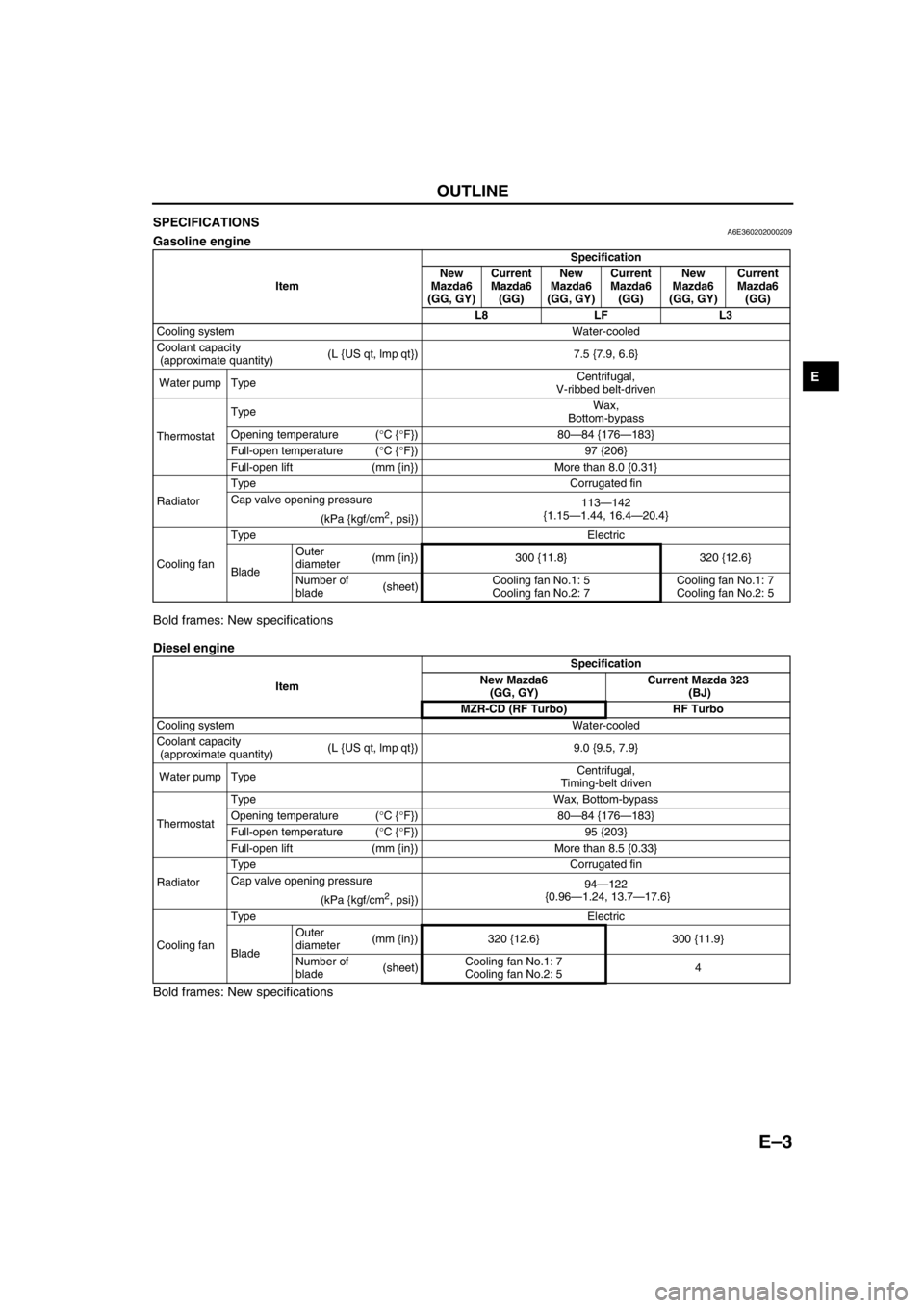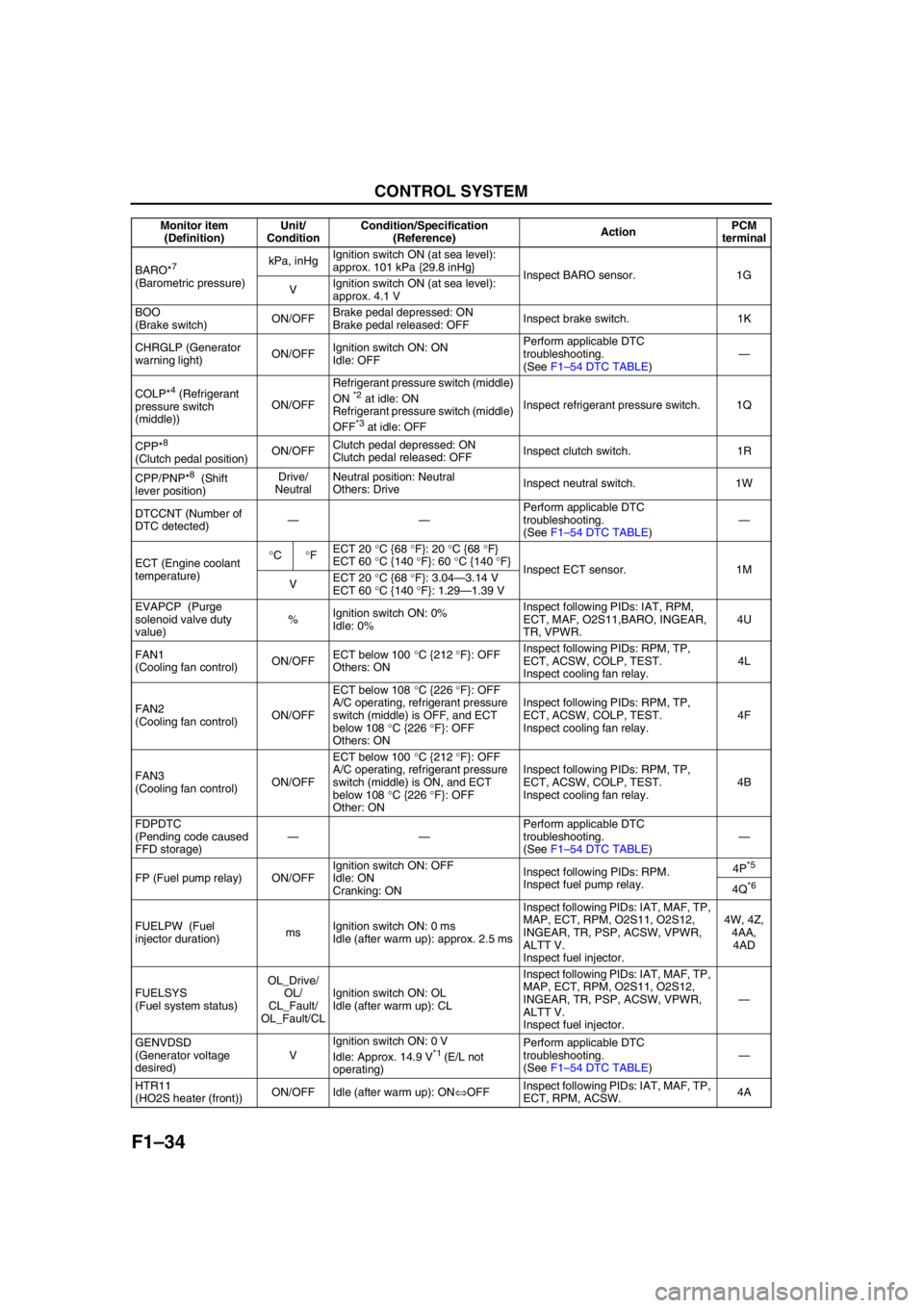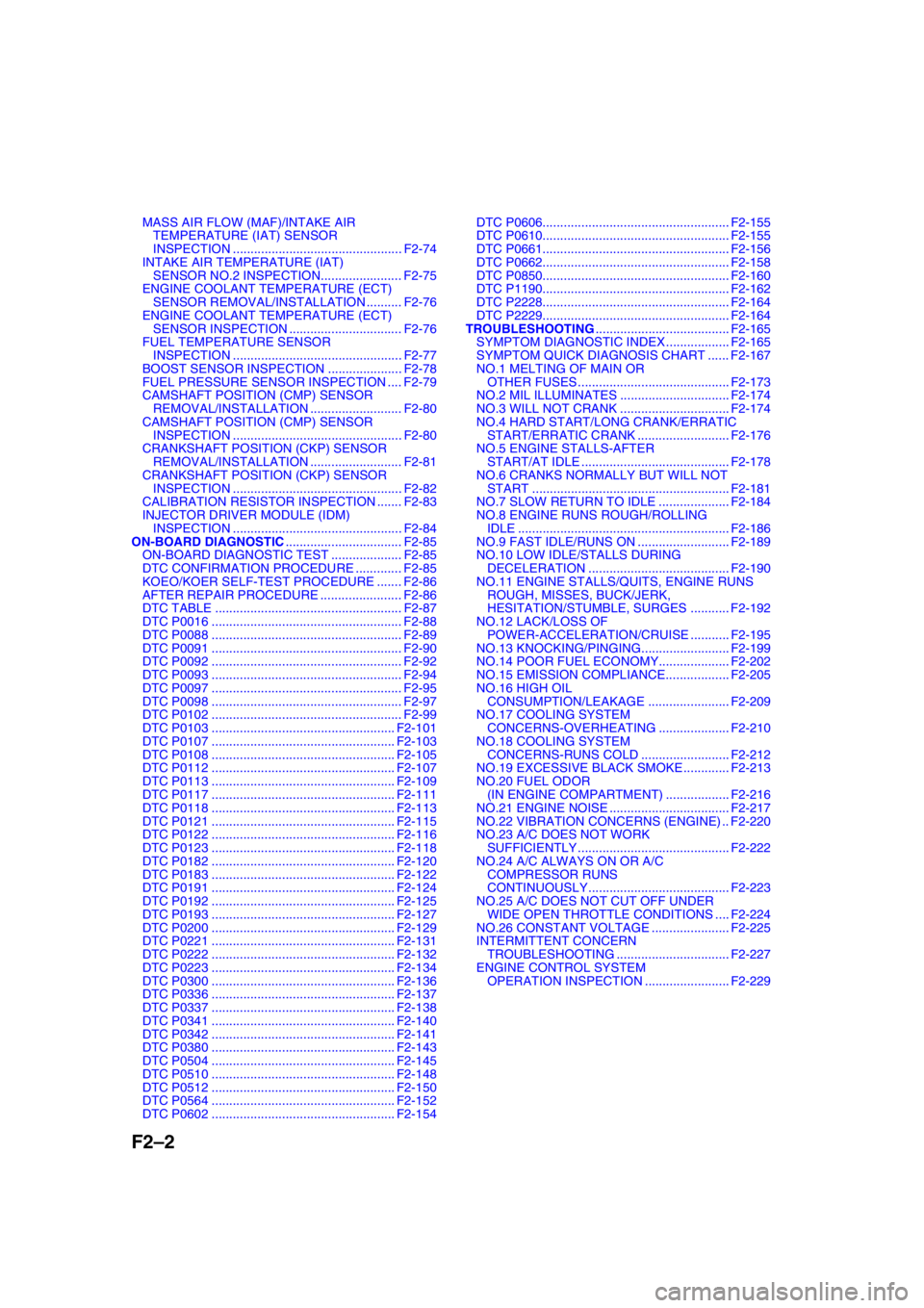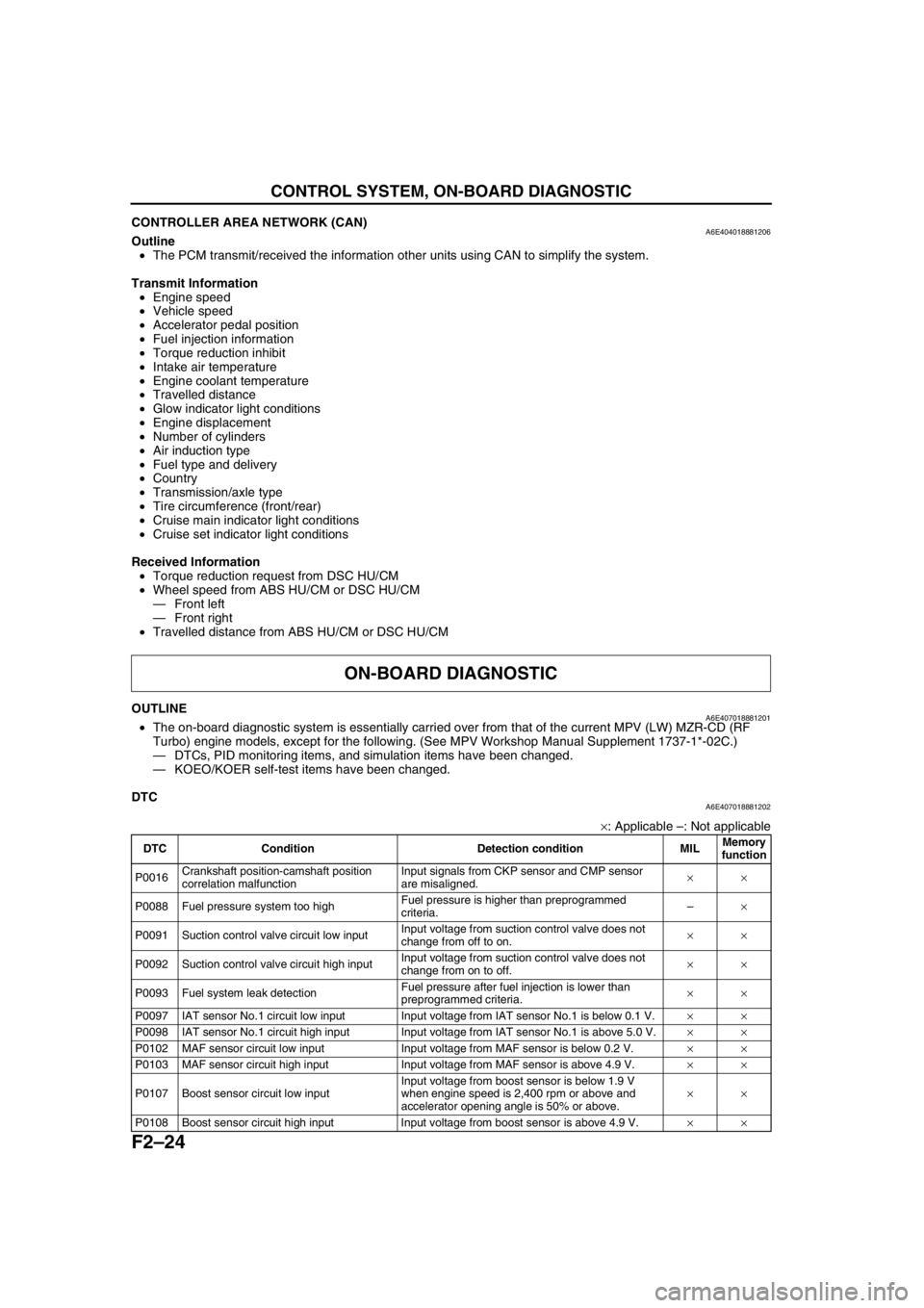coolant temperature MAZDA 6 2002 Workshop Manual Suplement
[x] Cancel search | Manufacturer: MAZDA, Model Year: 2002, Model line: 6, Model: MAZDA 6 2002Pages: 909, PDF Size: 17.16 MB
Page 8 of 909

NEW STANDARDS
GI–5
GINEW STANDARDS TABLEA6E202800020201•The following is a comparison of the previous standard and the new standard.
NEW STANDARDS
New Standard Previous Standard
Remark
Abbrevi-
ationNameAbbrevi-
ationName
AP Accelerator Pedal—Accelerator Pedal
ACL Air Cleaner—Air Cleaner
A/C Air Conditioning—Air Conditioning
BARO Barometric Pressure—Atmospheric Pressure
B+ Battery Positive VoltageV
BBattery Voltage
—Brake Switch—Stoplight Switch
—Calibration Resistor—Corrected Resistance #6
CMP sensor Camshaft Position Sensor—Crank Angle Sensor
CAC Charge Air Cooler—Intercooler
CLS Closed Loop System—Feedback System
CTP Closed Throttle Position—Fully Closed
—Closed Throttle Position Switch—Idle Switch
CPP Clutch Pedal Position—Clutch Position
CIS Continuous Fuel Injection System EGI Electronic Gasoline Injection System
CS sensor Control Sleeve Sensor CSP sensor Control Sleeve Position Sensor #6
CKP sensor Crankshaft Position Sensor—Crank Angle Sensor 2
DLC Data Link Connector—Diagnosis Connector
DTM Diagnostic Test Mode—Test Mode #1
DTC Diagnostic Trouble Code—Service Code(s)
DI Distributor Ignition—Spark Ignition
DLI Distributorless Ignition—Direct Ignition
EI Electronic Ignition—Electronic Spark Ignition #2
ECT Engine Coolant Temperature—Water Thermo
EM Engine Modification—Engine Modification
—Engine Speed Input Signal—Engine RPM Signal
EVAP Evaporative Emission—Evaporative Emission
EGR Exhaust Gas Recirculation—Exhaust Gas Recirculation
FC Fan Control—Fan Control
FF Flexible Fuel—Flexible Fuel
4GR Fourth Gear—Overdrive
—Fuel Pump Relay—Circuit Opening Relay #3
FSO
solenoidFuel Shut Off Solenoid FCV Fuel Cut Valve #6
GEN Generator—Alternator
GND Ground—Ground/Earth
HO2S Heated Oxygen Sensor—Oxygen Sensor With heater
IAC Idle Air Control—Idle Speed Control
—IDM Relay—Spill Valve Relay #6
—Incorrect Gear Ratio——
—Injection Pump FIP Fuel Injection Pump #6
—Input/Turbine Speed Sensor—Pulse Generator
IAT Intake Air Temperature—Intake Air Thermo
KS Knock Sensor—Knock Sensor
MIL Malfunction Indicator Lamp—Malfunction Indicator Light
MAP Manifold Absolute Pressure—Intake Air Pressure
MAF sensor Mass Air Flow Sensor—Airflow Sensor
MFI Multiport Fuel Injection—Multiport Fuel Injection
OBD On Board Diagnostic—Diagnosis/Self Diagnosis
Page 11 of 909

GI–8
SCHEDULED MAINTENANCE
SCHEDULED MAINTENANCE TABLEA6E203400013202For Europe (L.H.D. U.K.)
Chart symbols:
I : Inspect and clean, repair, adjust, or replace if necessary.
R:Replace
C : Clean
Remarks:
SCHEDULED MAINTENANCE
•To ensure efficient operation of the engine and all systems related to emission control, the ignition and fuel systems must
be serviced regularly. It is strongly recommended that all servicing related to these systems be done by an authorized
Mazda Dealer.
•After the described period, continue to follow the described maintenance at the recommended intervals.
•Refer below for a description of items marked* in the maintenance chart.
*1: If the vehicle is operated under any of the following conditions, change the engine oil and oil filter every 10,000 km
(6,250 miles) or shorter.
a. Driving in dusty conditions.
b. Extended periods of idling or low speed operation.
c. Driving for long period in cold temperatures or driving regularly at short distance only.
*2: Also inspect and adjust the power steering and air conditioner drive belts, if installed.
*3: If the brakes are used extensively (for example, continuous hard driving or mountain driving) or if the vehicle is
operated in extremely humid climates, change the brake fluid annually.
*4: If the vehicle is operated in very dusty or sandy areas, clean and if necessary, replace the air cleaner element more
often than the recommended intervals.
*5: Replacement of the timing belt is required at every 100,000 km (62,500 miles).
Failure to replace the timing belt may result in damage to the engine.
*6: Replacement of the timing belt is required at every 120,000 km (75,000 miles).
Failure to replace the timing belt may result in damage to the engine.
*7: If the vehicle is operated under any of the following conditions, change the rear differential oil
every 40,000 km (25,000 miles).
a. Towing a trailer or using a car - top carrier
b. Driving in dusty, sandy or wet condition
c. Extended periods of idling or low speed operation
d. Repeated short trips of less than 16 km (10 miles)
*8: If this component has been submerged in water, the oil should be changed.
Maintenance ItemMaintenance Interval (Number of months or km (miles), whichever comes first)
Months 12 24 36 48 60 72 84 96 108
×1000 km 20 40 60 80 100 120 140 160 180
×1000 miles 12.52537.55062.57587.5100112.5
GASOLINE ENGINE
Spark plugs Replace every 100,000 km (62,500 miles)
Air cleaner element *4 R R R
E.G.R. system I I
DIESEL ENGINE
Engine valve clearance I I
Engine timing beltFinland, Sweden, Norway*5 Replace every 100,000 km (62,500 miles)
Others*6 Replace every 120,000 km (75,000 miles)
Fuel filter R R R
Fuel injection system I I I I
Air cleaner element *4CCRCCRCCR
E.G.R. system I I I
GASOLINE and DIESEL ENGINE
Engine oil *1RRRRRRRRR
Engine oil filter *1RRRRRRRRR
Drive belts *2 I I I
Cooling system (including coolant level adjustment) I I I I
Page 13 of 909

GI–10
SCHEDULED MAINTENANCE
For Israel
Chart symbols:
I : Inspect and clean, repair, adjust, or replace if necessary.
R:Replace
C : Clean
Remarks:
•To ensure efficient operation of the engine and all systems related to emission control, the ignition and fuel systems must
be serviced regularly. It is strongly recommended that all servicing related to these systems be done by an authorized
Mazda Dealer.
•After the described period, continue to follow the described maintenance at the recommended intervals.
•Refer below for a description of items marked* in the maintenance chart.
*1: If the vehicle is operated under any of the following conditions, change the engine oil and oil filter every 10,000 km
(6,000 miles) or shorter.
a. Driving in dusty conditions.
b. Extended periods of idling or low speed operation.
c. Driving for long period in cold temperatures or driving regularly at short distance only.
*2: Also inspect and adjust the power steering and air conditioner drive belts, if installed.
*3: If the brakes are used extensively (for example, continuous hard driving or mountain driving) or if the vehicle is
operated in extremely humid climates, change the brake fluid annually.
*4: If the vehicle is operated in very dusty or sandy areas, clean and if necessary, replace the air cleaner element more
often than the recommended intervals.
*5: This is a full function check of electrical systems such as lights, wiper and washer systems (including wiper blades),
and power windows.
Maintenance ItemMaintenance Interval (Number of months or km (miles), whichever comes first)
Months 12 24 36 48 60 72 84 96 108 120 132 144
×1000 km 15 30 45 60 75 90 105 120 135 150 165 180
×1000 miles 9 18 27 36 45 54 63 72 81 90 99 108
ENGINE
Drive belts *2IIIIIIIIIII I
Engine oil *1RRRRRRRRRRR R
Engine oil filter *1RRRRRRRRRRR R
COOLING SYSTEM
Cooling system
(Including coolant level adjustment)IIIII I
Engine coolantReplace at first 4 years or 90,000 km (54,000 miles);
after that, every 2 years
FUEL SYSTEM
Air cleaner element *4CCCRCCCRCCC R
Fuel filter R R
Fuel lines & hoses IIIII I
IGNITION SYSTEM
Spark plugs Replace every 90,000 km (54,000 miles)
EMISSION CONTROL SYSTEM
Evaporative system I I I
E.G.R. system (if installed) I I I
ELECTRICAL SYSTEM
Battery electrolyte level & specific gravity I I I I I I I I I I I I
All electrical system *5IIIIIIIIIII I
CHASSIS & BODY
Brake & clutch pedals IIIIIIIIIII I
Brake lines, hoses & connections I I I I I I I I I I I I
Brake fluid *3IRIRIRIRIRI R
Parking brake IIIIIIIIIII I
Power brake unit & hoses IIIIIIIIIII I
Disc brakes IIIIIIIIIII I
Power steering fluid, lines, hoses, and
connectionsIIIIIIIIIII I
Page 14 of 909

SCHEDULED MAINTENANCE
GI–11
GI
For GCC
Chart symbols:
I : Inspect and clean, repair, adjust, or replace if necessary.
R : Replace
T:Tighten
C : Clean
Remarks:
End Of Sie
Steering operation & linkages IIIII I
Manual transaxle oil R R
Automatic transaxle fluid level IIIII I
Front & rear suspension & ball joints IIIII
Driveshaft dust boots IIIII
Exhaust system & heat shields IIIII I
Bolts & nuts on seats IIIII I
Body condition (for rust, corrosion & perforation) Inspect annually
Cabin air filter (if installed) R R R R R R R R R R R RMaintenance ItemMaintenance Interval (Number of months or km (miles), whichever comes first)
Months 12 24 36 48 60 72 84 96 108 120 132 144
×1000 km 15 30 45 60 75 90 105 120 135 150 165 180
×1000 miles 9 18 27 36 45 54 63 72 81 90 99 108
•To ensure efficient operation of the engine and all systems related to emission control, the ignition and fuel systems must
be serviced regularly. It is strongly recommended that all servicing related to these systems be done by an authorized
Mazda Dealer.
•After the described period, continue to follow the described maintenance at the recommended intervals.
•Refer below for a description of items marked* in the maintenance chart.
*1: If the vehicle is operated under any of the following conditions, change the engine oil and oil filter more often than
recommended intervals.
a. Driving in dusty conditions.
b. Extended periods of idling or low speed operation.
c. Driving for long period in cold temperatures or driving regularly at short distance only.
*2: Also inspect and adjust the power steering and air conditioner drive belts, if installed.
*3: If the brakes are used extensively (for example, continuous hard driving or mountain driving) or if the vehicle is
operated in extremely humid climates, change the brake fluid annually.
*4: If the vehicle is operated in very dusty or sandy areas, clean and if necessary, replace the air cleaner element more
often than the recommended intervals.
*5: This is a full function check of electrical systems such as lights, wiper and washer systems (including wiper blades),
and power windows.
*6: If the vehicle is operated under any of the following conditions, change the rear differential oil
every 45,000 km (27,000 miles).
a. Towing a trailer or using a car - top carrier
b. Driving in dusty, sandy or wet condition
c. Extended periods of idling or low speed operation
d. Repeated short trips of less than 16 km (10 miles)
*7: If this component has been submerged in water, the oil should be changed.
Maintenance ItemMaintenance Interval (Number of months or km (miles), whichever comes first)
Months 6 121824303642485460667278849096
×1000 km
10 20 30 40 50 60 70 80 90 100 110 120 130 140 150 160
×1000 miles6.25 12.5 18.75 25 31.25 37.5 43.75 50 56.25 62.5 68.75 75 81.25 87.5 93.75 100
ENGINE
Engine valve clearance (leaded fuel) I I I I
Drive belts *2IIIIIIIIIIIIIIII
Engine oil *1RRRRRRRRRRRRRRRR
Engine oil filter *1RRRRRRRRRRRRRRRR
COOLING SYSTEM
Cooling system IIIIIIII
Engine coolant Replace every 2 years
Page 17 of 909

SCHEDULED MAINTENANCE
GI–13
GI
For Israel
Applied VIN (assumed):
JMZ GG1235✻
✻✻ ✻
# 202316-, JMZ GG1435✻
✻✻ ✻
# 202316-, JMZ GY19F2✻
✻✻ ✻
# 146118-, JMZ GY19F5✻
✻✻ ✻
# 146118-
Chart symbols:
I : Inspect and clean, repair, adjust, or replace if necessary.
R : Replace
C : Clean
Remarks:
Engine oil *1 R R R R R R R R R
Engine oil filter *1RRRRRRRRR
Drive belts *2 I I I
Cooling system (including coolant level adjustment) I I I I
Engine coolantReplace at first 4 years or 100,000 km (62,500 miles);
after that, every 2 years
Fuel lines and hoses I I I I
Battery electrolyte level and specific gravity IIIIIIIII
Brake fluid *3 R R R R
Brake lines, hoses and connections IIIIIIIII
Parking brake IIIIIIIII
Power brake unit and hoses IIIIIIIII
Disc brakes IIIIIIIII
Power steering fluid, lines, hoses, and connections IIIIIIIII
Steering operation and linkages I I I I
Manual transaxle oil R
Automatic transaxle fluid level I I I
Rear differential oil (for 4WD)
*7*8
Transfer oil (for 4WD)
*8
Front and rear suspension and ball joints I I I I
Driveshaft dust boots I I I I
Exhaust system and heat shields I I
Cabin air filter (if installed) (pollen filter) R R R R
Body condition
(for rust, corrosion and perforation)Inspect annually
Tires (including spare tyre)
(with inflation pressure adjustment)IIIIIIIII Maintenance ItemMaintenance Interval (Number of months or km (miles), whichever comes first)
Months 12 24 36 48 60 72 84 96 108
×1000 km 20 40 60 80 100 120 140 160 180
×1000 miles 12.5 25 37.5 50 62.5 75 87.5 100 112.5
•The ignition and fuel systems are highly important to the emission control system and to efficient engine operation. All
inspections and adjustments must be made by an Authorized Mazda Dealer.
•After the prescribed period, continue to follow the described maintenance at the recommended intervals.
•Refer below for a description of items marked* in the maintenance chart.
*1: If the vehicle is operated under any of the following conditions, change the engine oil and oil filter every 10,000 km
(6,250 miles) or shorter.
a. Driving in dusty conditions.
b. Extended periods of idling or low speed operation.
c. Driving for long period in cold temperatures or driving regularly at short distance only.
*2: Also inspect and adjust the power steering and air conditioner drive belts, if installed.
*3: If the brakes are used extensively (for example, continuous hard driving or mountain driving) or if the vehicle is
operated in extremely humid climates, change the brake fluid annually.
*4: If the vehicle is operated in very dusty or sandy areas, clean and if necessary, replace the air cleaner element more
often than the recommended intervals.
*5: This is a full function check of electrical systems such as lights, wiper and washer systems (including wiper blades),
and power windows.
Page 19 of 909

SCHEDULED MAINTENANCE
GI–15
GI
For GCC
Applied VIN (assumed):
JM7 GG323✻✻
✻✻✻✻ ✻✻
# 128767-, JM7 GG423✻✻
✻✻✻✻ ✻✻
# 128767-, JM7 GG343✻✻
✻✻✻✻ ✻✻
# 128767-
JM7 GG443✻✻
✻✻✻✻ ✻✻
# 128767-, JM7 GG32F✻✻
✻✻✻✻ ✻✻
# 128767-, JM7 GG42F✻✻
✻✻✻✻ ✻✻
# 128767-
JM7 GG34F✻
✻✻ ✻✻
✻✻ ✻
# 128767-, JM7 GG44F✻
✻✻ ✻✻
✻✻ ✻
# 128767-, JM7 GY49F✻✻
✻✻✻✻ ✻✻
# 101432-
JM7 GY39F✻✻
✻✻✻✻ ✻✻
# 101432-, JM7 GY49F✻
✻✻ ✻
0# 101432-, JM7 GY39F✻
✻✻ ✻
0# 101432-
Chart symbols:
I : Inspect and clean, repair, adjust, or replace if necessary.
R : Replace
T:Tighten
C : Clean
Remarks:
•The ignition and fuel systems are highly important to the emission control system and to efficient engine operation. All
inspections and adjustments must be made by an Authorized Mazda Dealer.
•After the prescribed period, continue to follow the described maintenance at the recommended intervals.
•Refer below for a description of items marked* in the maintenance chart.
*1: If the vehicle is operated under any of the following conditions, change the engine oil and oil filter more often than
recommended intervals.
a. Driving in dusty conditions.
b. Extended periods of idling or low speed operation.
c. Driving for long period in cold temperatures or driving regularly at short distance only.
*2: Also inspect and adjust the power steering and air conditioner drive belts, if installed.
*3: If the brakes are used extensively (for example, continuous hard driving or mountain driving) or if the vehicle is
operated in extremely humid climates, change the brake fluid annually.
*4: If the vehicle is operated in very dusty or sandy areas, clean and if necessary, replace the air cleaner element more
often than the recommended intervals.
*5: This is a full function check of electrical systems such as lights, wiper and washer systems (including wiper blades),
and power windows.
*6: If the vehicle is operated under any of the following conditions, change the rear differential oil
every 45,000 km (27,000 miles).
a. Towing a trailer or using a car - top carrier
b. Driving in dusty, sandy or wet condition
c. Extended periods of idling or low speed operation
d. Repeated short trips of less than 16 km (10 miles)
*7: If this component has been submerged in water, the oil should be changed.
Maintenance ItemMaintenance Interval (Number of months or km (miles), whichever comes first)
Months 6 121824303642485460667278849096
×1000 km
10 20 30 40 50 60 70 80 90 100 110 120 130 140 150 160
×1000 miles6.25 12.5 18.75 25 31.25 37.5 43.75 50 56.25 62.5 68.75 75 81.25 87.5 93.75 100
ENGINE
Engine valve clearance Unleaded fuel Audible inspect every 120,000 km (75,000 miles), if noisy, adjust
leaded fuel I I I I
Drive belts *2IIIIIIIIIIIIIIII
Engine oil *1RRRRRRRRRRRRRRRR
Engine oil filter *1RRRRRRRRRRRRRRRR
COOLING SYSTEM
Cooling system IIIIIIII
Engine coolant Replace every 2 years
FUEL SYSTEM
Air cleaner element *4CCRCCRCC
Fuel filter R R R R
Fuel lines and hoses IIIIIIII
IGNITION SYSTEM
Spark plugs Unleaded fuel Replace every 100,000 km (62,500 miles)
Leaded fuel IIIIIIII
EMISSION CONTROL SYSTEM
Idle mixture (leaded fuel) IIIIIIII
Page 78 of 909

OUTLINE
E–3
E
SPECIFICATIONSA6E360202000209Gasoline engine
Bold frames: New specifications
Diesel engine
Bold frames: New specifications
End Of Sie
ItemSpecification
New
Mazda6
(GG, GY)Current
Mazda6
(GG)New
Mazda6
(GG, GY)Current
Mazda6
(GG)New
Mazda6
(GG, GY)Current
Mazda6
(GG)
L8 LF L3
Cooling system Water-cooled
Coolant capacity
(approximate quantity)(L {US qt, lmp qt}) 7.5 {7.9, 6.6}
Water pump TypeCentrifugal,
V-ribbed belt-driven
ThermostatTypeWax,
Bottom-bypass
Opening temperature (°C {°F}) 80—84 {176—183}
Full-open temperature (°C {°F}) 97 {206}
Full-open lift (mm {in}) More than 8.0 {0.31}
RadiatorType Corrugated fin
Cap valve opening pressure
113—142
{1.15—1.44, 16.4—20.4}
(kPa {kgf/cm
2, psi})
Cooling fanType Electric
BladeOuter
diameter(mm {in}) 300 {11.8} 320 {12.6}
Number of
blade(sheet)Cooling fan No.1: 5
Cooling fan No.2: 7Cooling fan No.1: 7
Cooling fan No.2: 5
ItemSpecification
New Mazda6
(GG, GY)Current Mazda 323
(BJ)
MZR-CD (RF Turbo) RF Turbo
Cooling system Water-cooled
Coolant capacity
(approximate quantity)(L {US qt, lmp qt}) 9.0 {9.5, 7.9}
Water pump TypeCentrifugal,
Timing-belt driven
ThermostatType Wax, Bottom-bypass
Opening temperature (°C {°F}) 80—84 {176—183}
Full-open temperature (°C {°F}) 95 {203}
Full-open lift (mm {in}) More than 8.5 {0.33}
RadiatorType Corrugated fin
Cap valve opening pressure
94—122
{0.96—1.24, 13.7—17.6}
(kPa {kgf/cm
2, psi})
Cooling fanType Electric
BladeOuter
diameter(mm {in}) 320 {12.6} 300 {11.9}
Number of
blade(sheet)Cooling fan No.1: 7
Cooling fan No.2: 54
Page 122 of 909

F1–34
CONTROL SYSTEM
BARO*7
(Barometric pressure)kPa, inHgIgnition switch ON (at sea level):
approx. 101 kPa {29.8 inHg}
Inspect BARO sensor. 1G
VIgnition switch ON (at sea level):
approx. 4.1 V
BOO
(Brake switch)ON/OFFBrake pedal depressed: ON
Brake pedal released: OFFInspect brake switch. 1K
CHRGLP (Generator
warning light)ON/OFFIgnition switch ON: ON
Idle: OFFPerform applicable DTC
troubleshooting.
(See F1–54 DTC TABLE)—
COLP*
4 (Refrigerant
pressure switch
(middle))ON/OFFRefrigerant pressure switch (middle)
ON *2 at idle: ON
Refrigerant pressure switch (middle)
OFF
*3 at idle: OFFInspect refrigerant pressure switch. 1Q
CPP*
8
(Clutch pedal position)ON/OFFClutch pedal depressed: ON
Clutch pedal released: OFFInspect clutch switch. 1R
CPP/PNP*
8 (Shift
lever position)Drive/
NeutralNeutral position: Neutral
Others: DriveInspect neutral switch. 1W
DTCCNT (Number of
DTC detected)——Perform applicable DTC
troubleshooting.
(See F1–54 DTC TABLE)—
ECT (Engine coolant
temperature)°C°FECT 20 °C {68 °F}: 20 °C {68 °F}
ECT 60 °C {140 °F}: 60 °C {140 °F}
Inspect ECT sensor. 1M
VECT 20 °C {68 °F}: 3.04—3.14 V
ECT 60 °C {140 °F}: 1.29—1.39 V
EVAPCP (Purge
solenoid valve duty
value)%Ignition switch ON: 0%
Idle: 0%Inspect following PIDs: IAT, RPM,
ECT, MAF, O2S11,BARO, INGEAR,
TR, VPWR.4U
FAN1
(Cooling fan control)ON/OFFECT below 100 °C {212 °F}: OFF
Others: ONInspect following PIDs: RPM, TP,
ECT, ACSW, COLP, TEST.
Inspect cooling fan relay.4L
FAN2
(Cooling fan control)ON/OFFECT below 108 °C {226 °F}: OFF
A/C operating, refrigerant pressure
switch (middle) is OFF, and ECT
below 108 °C {226 °F}: OFF
Others: ONInspect following PIDs: RPM, TP,
ECT, ACSW, COLP, TEST.
Inspect cooling fan relay.4F
FAN3
(Cooling fan control)ON/OFFECT below 100 °C {212 °F}: OFF
A/C operating, refrigerant pressure
switch (middle) is ON, and ECT
below 108 °C {226 °F}: OFF
Other: ONInspect following PIDs: RPM, TP,
ECT, ACSW, COLP, TEST.
Inspect cooling fan relay.4B
FDPDTC
(Pending code caused
FFD storage)——Perform applicable DTC
troubleshooting.
(See F1–54 DTC TABLE)—
FP (Fuel pump relay) ON/OFFIgnition switch ON: OFF
Idle: ON
Cranking: ONInspect following PIDs: RPM.
Inspect fuel pump relay.4P
*5
4Q*6
FUELPW (Fuel
injector duration)msIgnition switch ON: 0 ms
Idle (after warm up): approx. 2.5 msInspect following PIDs: IAT, MAF, TP,
MAP, ECT, RPM, O2S11, O2S12,
INGEAR, TR, PSP, ACSW, VPWR,
ALTT V.
Inspect fuel injector.4W, 4Z,
4AA,
4AD
FUELSYS
(Fuel system status)OL_Drive/
OL/
CL_Fault/
OL_Fault/CLIgnition switch ON: OL
Idle (after warm up): CLInspect following PIDs: IAT, MAF, TP,
MAP, ECT, RPM, O2S11, O2S12,
INGEAR, TR, PSP, ACSW, VPWR,
ALTT V.
Inspect fuel injector.—
GENVDSD
(Generator voltage
desired)VIgnition switch ON: 0 V
Idle: Approx. 14.9 V
*1 (E/L not
operating)Perform applicable DTC
troubleshooting.
(See F1–54 DTC TABLE)—
HTR11
(HO2S heater (front))ON/OFF Idle (after warm up): ON⇔OFFInspect following PIDs: IAT, MAF, TP,
ECT, RPM, ACSW.4A Monitor item
(Definition)Unit/
ConditionCondition/Specification
(Reference)ActionPCM
terminal
Page 154 of 909

F2–2
MASS AIR FLOW (MAF)/INTAKE AIR
TEMPERATURE (IAT) SENSOR
INSPECTION ................................................ F2-74
INTAKE AIR TEMPERATURE (IAT)
SENSOR NO.2 INSPECTION....................... F2-75
ENGINE COOLANT TEMPERATURE (ECT)
SENSOR REMOVAL/INSTALLATION .......... F2-76
ENGINE COOLANT TEMPERATURE (ECT)
SENSOR INSPECTION ................................ F2-76
FUEL TEMPERATURE SENSOR
INSPECTION ................................................ F2-77
BOOST SENSOR INSPECTION ..................... F2-78
FUEL PRESSURE SENSOR INSPECTION .... F2-79
CAMSHAFT POSITION (CMP) SENSOR
REMOVAL/INSTALLATION .......................... F2-80
CAMSHAFT POSITION (CMP) SENSOR
INSPECTION ................................................ F2-80
CRANKSHAFT POSITION (CKP) SENSOR
REMOVAL/INSTALLATION .......................... F2-81
CRANKSHAFT POSITION (CKP) SENSOR
INSPECTION ................................................ F2-82
CALIBRATION RESISTOR INSPECTION ....... F2-83
INJECTOR DRIVER MODULE (IDM)
INSPECTION ................................................ F2-84
ON-BOARD DIAGNOSTIC................................. F2-85
ON-BOARD DIAGNOSTIC TEST .................... F2-85
DTC CONFIRMATION PROCEDURE ............. F2-85
KOEO/KOER SELF-TEST PROCEDURE ....... F2-86
AFTER REPAIR PROCEDURE ....................... F2-86
DTC TABLE ..................................................... F2-87
DTC P0016 ...................................................... F2-88
DTC P0088 ...................................................... F2-89
DTC P0091 ...................................................... F2-90
DTC P0092 ...................................................... F2-92
DTC P0093 ...................................................... F2-94
DTC P0097 ...................................................... F2-95
DTC P0098 ...................................................... F2-97
DTC P0102 ...................................................... F2-99
DTC P0103 .................................................... F2-101
DTC P0107 .................................................... F2-103
DTC P0108 .................................................... F2-105
DTC P0112 .................................................... F2-107
DTC P0113 .................................................... F2-109
DTC P0117 .................................................... F2-111
DTC P0118 .................................................... F2-113
DTC P0121 .................................................... F2-115
DTC P0122 .................................................... F2-116
DTC P0123 .................................................... F2-118
DTC P0182 .................................................... F2-120
DTC P0183 .................................................... F2-122
DTC P0191 .................................................... F2-124
DTC P0192 .................................................... F2-125
DTC P0193 .................................................... F2-127
DTC P0200 .................................................... F2-129
DTC P0221 .................................................... F2-131
DTC P0222 .................................................... F2-132
DTC P0223 .................................................... F2-134
DTC P0300 .................................................... F2-136
DTC P0336 .................................................... F2-137
DTC P0337 .................................................... F2-138
DTC P0341 .................................................... F2-140
DTC P0342 .................................................... F2-141
DTC P0380 .................................................... F2-143
DTC P0504 .................................................... F2-145
DTC P0510 .................................................... F2-148
DTC P0512 .................................................... F2-150
DTC P0564 .................................................... F2-152
DTC P0602 .................................................... F2-154DTC P0606..................................................... F2-155
DTC P0610..................................................... F2-155
DTC P0661..................................................... F2-156
DTC P0662..................................................... F2-158
DTC P0850..................................................... F2-160
DTC P1190..................................................... F2-162
DTC P2228..................................................... F2-164
DTC P2229..................................................... F2-164
TROUBLESHOOTING...................................... F2-165
SYMPTOM DIAGNOSTIC INDEX .................. F2-165
SYMPTOM QUICK DIAGNOSIS CHART ...... F2-167
NO.1 MELTING OF MAIN OR
OTHER FUSES ........................................... F2-173
NO.2 MIL ILLUMINATES ............................... F2-174
NO.3 WILL NOT CRANK ............................... F2-174
NO.4 HARD START/LONG CRANK/ERRATIC
START/ERRATIC CRANK .......................... F2-176
NO.5 ENGINE STALLS-AFTER
START/AT IDLE .......................................... F2-178
NO.6 CRANKS NORMALLY BUT WILL NOT
START ........................................................ F2-181
NO.7 SLOW RETURN TO IDLE .................... F2-184
NO.8 ENGINE RUNS ROUGH/ROLLING
IDLE ............................................................ F2-186
NO.9 FAST IDLE/RUNS ON .......................... F2-189
NO.10 LOW IDLE/STALLS DURING
DECELERATION ........................................ F2-190
NO.11 ENGINE STALLS/QUITS, ENGINE RUNS
ROUGH, MISSES, BUCK/JERK,
HESITATION/STUMBLE, SURGES ........... F2-192
NO.12 LACK/LOSS OF
POWER-ACCELERATION/CRUISE ........... F2-195
NO.13 KNOCKING/PINGING......................... F2-199
NO.14 POOR FUEL ECONOMY.................... F2-202
NO.15 EMISSION COMPLIANCE.................. F2-205
NO.16 HIGH OIL
CONSUMPTION/LEAKAGE ....................... F2-209
NO.17 COOLING SYSTEM
CONCERNS-OVERHEATING .................... F2-210
NO.18 COOLING SYSTEM
CONCERNS-RUNS COLD ......................... F2-212
NO.19 EXCESSIVE BLACK SMOKE ............. F2-213
NO.20 FUEL ODOR
(IN ENGINE COMPARTMENT) .................. F2-216
NO.21 ENGINE NOISE .................................. F2-217
NO.22 VIBRATION CONCERNS (ENGINE) .. F2-220
NO.23 A/C DOES NOT WORK
SUFFICIENTLY ........................................... F2-222
NO.24 A/C ALWAYS ON OR A/C
COMPRESSOR RUNS
CONTINUOUSLY........................................ F2-223
NO.25 A/C DOES NOT CUT OFF UNDER
WIDE OPEN THROTTLE CONDITIONS .... F2-224
NO.26 CONSTANT VOLTAGE ...................... F2-225
INTERMITTENT CONCERN
TROUBLESHOOTING ................................ F2-227
ENGINE CONTROL SYSTEM
OPERATION INSPECTION ........................ F2-229
Page 176 of 909

F2–24
CONTROL SYSTEM, ON-BOARD DIAGNOSTIC
CONTROLLER AREA NETWORK (CAN)A6E404018881206Outline
•The PCM transmit/received the information other units using CAN to simplify the system.
Transmit Information
•Engine speed
•Vehicle speed
•Accelerator pedal position
•Fuel injection information
•Torque reduction inhibit
•Intake air temperature
•Engine coolant temperature
•Travelled distance
•Glow indicator light conditions
•Engine displacement
•Number of cylinders
•Air induction type
•Fuel type and delivery
•Country
•Transmission/axle type
•Tire circumference (front/rear)
•Cruise main indicator light conditions
•Cruise set indicator light conditions
Received Information
•Torque reduction request from DSC HU/CM
•Wheel speed from ABS HU/CM or DSC HU/CM
—Front left
—Front right
•Travelled distance from ABS HU/CM or DSC HU/CM
End Of Sie
OUTLINEA6E407018881201•The on-board diagnostic system is essentially carried over from that of the current MPV (LW) MZR-CD (RF
Turbo) engine models, except for the following. (See MPV Workshop Manual Supplement 1737-1*-02C.)
—DTCs, PID monitoring items, and simulation items have been changed.
—KOEO/KOER self-test items have been changed.
End Of Sie
DTCA6E407018881202
×: Applicable –: Not applicable
ON-BOARD DIAGNOSTIC
DTC Condition Detection condition MILMemory
function
P0016Crankshaft position-camshaft position
correlation malfunctionInput signals from CKP sensor and CMP sensor
are misaligned.××
P0088 Fuel pressure system too highFuel pressure is higher than preprogrammed
criteria.–×
P0091 Suction control valve circuit low inputInput voltage from suction control valve does not
change from off to on.××
P0092 Suction control valve circuit high inputInput voltage from suction control valve does not
change from on to off.××
P0093 Fuel system leak detectionFuel pressure after fuel injection is lower than
preprogrammed criteria.××
P0097 IAT sensor No.1 circuit low input Input voltage from IAT sensor No.1 is below 0.1 V.××
P0098 IAT sensor No.1 circuit high input Input voltage from IAT sensor No.1 is above 5.0 V.××
P0102 MAF sensor circuit low input Input voltage from MAF sensor is below 0.2 V.××
P0103 MAF sensor circuit high input Input voltage from MAF sensor is above 4.9 V.××
P0107 Boost sensor circuit low inputInput voltage from boost sensor is below 1.9 V
when engine speed is 2,400 rpm or above and
accelerator opening angle is 50% or above.××
P0108 Boost sensor circuit high input Input voltage from boost sensor is above 4.9 V.××